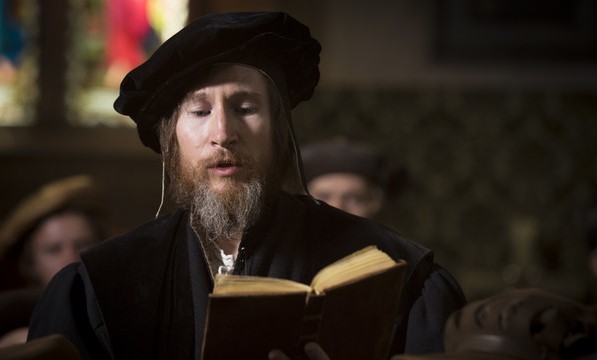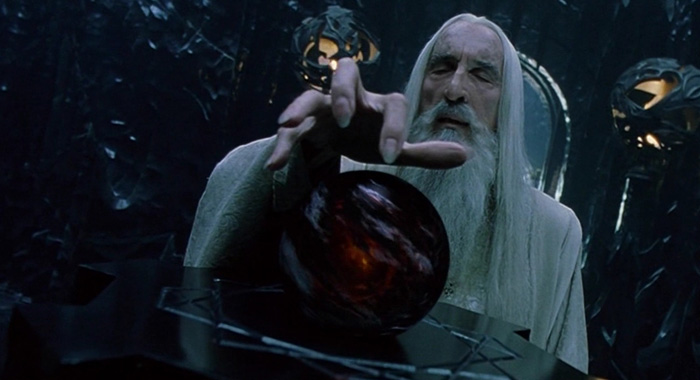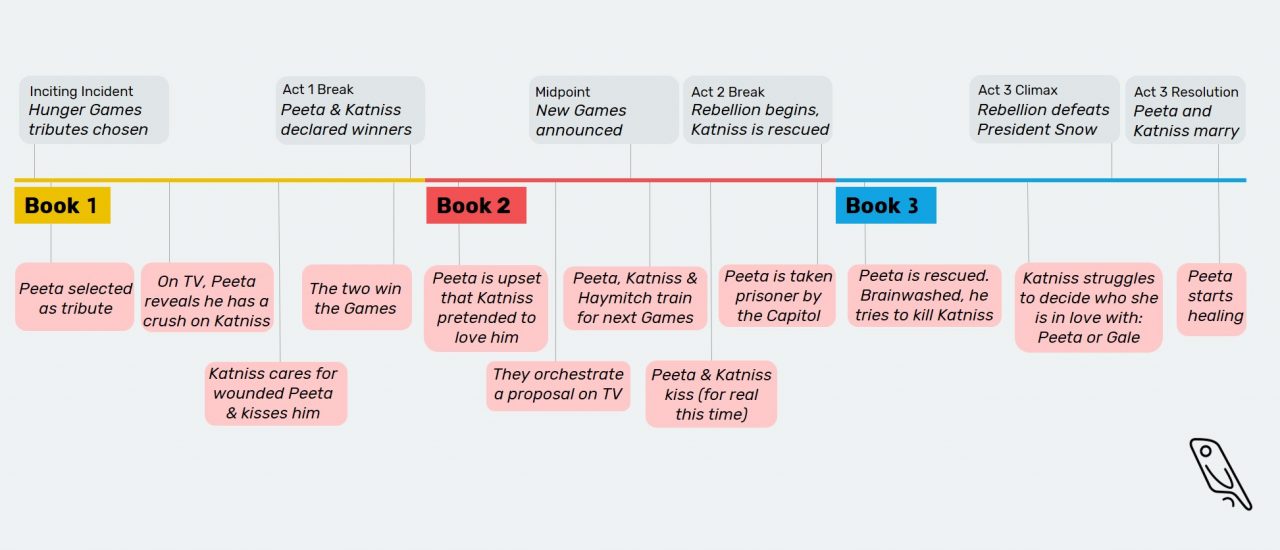Posted on Jun 17, 2020
How to Write a Trilogy in 6 Steps
It’s hardly a surprise that you want to know how to write a trilogy — there’s something inherently satisfying about the number three and its ubiquity in Western culture. You can see it in the holy trinity, the three witches in Macbeth, and the Latin dictum omne trium perfectum, or “everything in threes is perfect.” The best trilogies utilize this power of three to structure and narrate powerful and enduring stories.
Writing a trilogy takes research and planning skills, but as long as you commit to organizing your ideas, and follow the six steps below, you’ll be on your way to writing a three-part series that readers will love.
Step 1: Study popular trilogies in your genre

The key to beginning any writing project is to read around it. This is critical for structurally complex works like trilogies, where the author must find a balance between long-term plot and characterization, while also producing satisfying conclusions in each installment.
Know the tropes of your genre inside-out
Familiarize yourself with the tropes of trilogies — specifically the ones in your genre. Once you know them well, you can make your stories more impressive by playing into tropes or subverting them.
Trilogies are more common in sci-fi, fantasy, YA, and dystopian fiction, but they can appear in almost any genre: a few notable examples include the Wolf Hall trilogy by Hilary Mantel (historical/literary fiction), The Century Trilogy by Ken Follett (historical fiction), and The Millenium Trilogy by Stieg Larsson (crime fiction). Just know that if you’re trying to write a romance trilogy, The Lord of the Rings isn’t likely to be much help (though Gimli and Legolas ‘shippers’ may beg to disagree).
Read like a detective
Even if you’ve already read many trilogies, chances are you didn’t read them while wondering how to write a trilogy yourself, so return to them with the forensic, inquisitive eye of a writer. Take careful notes on which plot development methods work and how the writer pulled them off — you can refer back to these if you run into any structuring issues ahead.
Top tip: Stick a bookmark in the page whenever there are important developments, so that you can then put the books next to each other, and be able to see the macroscale pacing across the entire trilogy! If your paperbacks end up looking like a ratty ream of highlighted lines, messy scribbles, and colorful post-its, you’re doing it right.
Step 2: Pick your driving force
Since you want to know how to write a trilogy, you’ll likely have a sense of your overarching plot. But how can you crystallize that into a coherent three-part story? The good news is, you can start a little messily — just free-write whatever images, plot strands, or character notes you hold in your mind.
Once you’ve got as much down as possible, start organizing your notes with the drive of your trilogy in mind. There are two key elements that this drive can derive from: character and plot.
Both are important, but one will prevail. Perhaps taking a look at the two trilogy models based on these two factors can give you a better idea of which works best for your story.
Character-based model
Character-based trilogies take as their defining feature the growth, or deliberate lack thereof, of a character or group of characters.
In the case of growth, the trilogy finds the protagonist a wholly different person at the end of the story, a dynamic character changed by the preceding events: maybe their priorities change, they become morally corrupt, or they realize who they are supposed to be.
Another version of character-based trilogies features no character growth. Instead, the static persistence of a character’s values and personality, despite challenges to their integrity, is thematized and highlighted. Lisbeth Salander in The Millenium Trilogy is one such example, where resilience and morality endure in the face of abuse, external obstacles, and the failure of society.
Plot-based model
Plot-based trilogies, on the other hand, focus primarily on the progression of a story, be it a mission, a quest, or an overarching theme. The characters’ profiles are secondary to the plot.
Popular examples include J. R. R. Tolkien’s The Lord of the Rings and Philip Pullman’s His Dark Materials. In both of these trilogies, the quest takes center stage, despite the occurrence of character development. Tolkien’s masterpiece follows the shape of a hero’s journey, but ultimately, the reader wants to see Sauron (the enemy) defeated more than they’re interested in protagonist Frodo’s emotional maturing.

Step 3: Choose your plot structure
One tricky element comes up a lot when writers wonder how to write a trilogy: structure. Now that you've clarified your story's priorities, the best way to sustain the reader’s interest throughout is to plan in advance — and below are four structures you can use to do that.
The complex arc
This popular method divides the story into three narrative arcs (one per book), all of which make up a larger arc that spans the whole trilogy. Every book is then broken down into three acts, begins with an inciting incident that spurs the plot onward, and contains its own “climax,” though let’s call these “act breaks” to distinguish from the final climax.

Suzanne Collins’ The Hunger Games is an excellent example of this structure, so we’ve identified its key plot points, as bolded in the chart above (spoilers ahead!)
In the first book, Katniss, a plucky young hunter from a poor district of dystopian Panem is entered into a televised contest where only one person may survive (INCITING INCIDENT). Refusing to play by the rules, she becomes a fan favorite, "beats" the system, and saves her friend/romantic interest, Peeta. The totalitarian regime is furious (ACT 1 BREAK).
In the second book, widespread rebellion has Katniss desperately trying to appease an angry President. She is then suddenly re-entered into a 75-year anniversary special edition Games (MIDPOINT). In the eyes of the public, Katniss becomes the mockingjay, symbol of the revolution, and a band of rebels rescues her from the Games by (ACT 2 BREAK).
In the final book, Katniss agrees to support the rebels, but ignores their instructions and sets off to kill the President. However, she ends up killing the leader of the rebellion instead, having realized that both are after power (CLIMAX). Eventually, Katniss and Peeta get married and begin healing together (RESOLUTION).
If complex arcs seem confusing, worry not, Reedsy’s Shaelin is here to walk you through them!
The long arc
The “long arc” trope is where individual books don’t have narrative arcs themselves — they basically tell one story, split into three volumes. These can be trickier, with the second book being treacherous ground, as it contains none of the excitement of a beginning (like worldbuilding) or the resolution of an end.
A long arc may sound tedious, but it doesn’t have to be — just look at the beloved epic The Lord of the Rings. Book One (60-year-old spoiler alert!) concludes with Frodo, the protagonist who’s on a quest to destroy an evil and powerful ring, leaving his team behind. Similarly, Book Two ends with Sam, Frodo’s friend, continuing the mission alone, thinking Frodo dead. Neither ending provides resolution, yet both spur the reader onward.
Episodic trilogies
An episodic trilogy is a series of three distinct stories, rather than one long narrative. It typically features the same set of characters in three largely unrelated tales. The Hardy Boys’ Murder House Trilogy takes this form, with each book taking young readers on a unique detective adventure. If you’re writing an episodic trilogy, you can pretty much go ahead and plan the individual books — there’s really no need to worry about overarching planning.
Irregular or atypical trilogies
Of course, there are always structures that defy categorization, like:
- uniting three completely separate novels into a trilogy, or
- creating two arcs over the span of three books.
Let’s take a quick look at two examples.
Paul Auster’s postmodern The New York Trilogy consists of three novels dealing with different characters and plots, although all three are connected by subtle thematic links.
As for the two-arcs-in-three-books structure, that seems to be where Philip Pullman’s ongoing trilogy The Book of Dust is headed. Book One, La Belle Sauvage, is an independent prequel to His Dark Materials, set 12 years earlier. Book Two, The Secret Commonwealth, re-acquaints the reader with some of these characters 20 years later and ends with many unanswered questions, which the author has suggested will be answered in the next book, continuing the arc of The Secret Commonwealth.
Step 4: Outline every book on a trilogy map
Now the real fun begins — let’s start organizing your own plot according to your preferred structure! One simple way to produce a visual outline, though there are many, is to draw a horizontal line, divide it into three segments, and begin annotating your major plot points onto a trilogy map.

To keep track of your various story elements, you can color-code each plot strand. In the below example, we’ve traced Peeta’s story in The Hunger Games trilogy in pink. Next, we could add the perspectives of Katniss and Gale (romantic interest #2!), to track how their love triangle coincides with the action plot.
A warning for perfectionists: don’t get too attached to your trilogy map, as you’ll have to revise and change it as you go. It’ll be messy (and we know that can be heart-breaking!), but you can always return to it should your writing take a new direction.
Step 5: Write the first book, one word at a time
You were hoping to know how to write a trilogy — well, now you do, and it’s time to get started! Sit down with your cup of coffee (or your magical writing juice of choice), roll your shoulders back, and have a go at it. We believe in you!
Here are some resources and tips to help you on your way:
- How to Start a Novel: 8 Steps to the Perfect Opening Scene
- Pacing in Writing: 10 Powerful Ways to Keep Readers Hooked
- How to Write Natural Dialogue in 11 Steps, With Examples
Don’t try to assemble the whole trilogy at once
First, ensure that Book One satisfies on its own and that its arc has a solid conclusion. Before you can entice readers to follow your characters to the final page of Book Three, you must first draw them into this universe with Book One. If you’re writing a complex arc trilogy, the first book is your only chance to hook readers into your epic plot; for a character-driven work, the first book is where fans must begin to care for your characters.
Too many unanswered questions in the first book can be deeply unsatisfying, even if you plan to address them later. Focus on making the first installment as appealing as possible; don’t assume that everyone will stick around for Books Two and Three! If you write with consideration for your readers’ needs, they’ll hang around for the rest of the trilogy.

Step 6: Publish the first book and start collecting feedback
It’s time for the home run: polish your work as much as you can, make publishing decisions, and listen to your readers with a long-term game-plan. This could be the beginning of an epic fandom!
Edit and publish Book One
Your first draft will have to undergo rounds of editing and revision. Take a break after completing it and return to your work armed with bravery and optimism. Editing is hard work, but your book will only emerge improved.
Weigh up whether you want to self-publish or traditionally publish your book.
Self-publishing gives you more creative control and higher royalties, but requires a significant time investment. You don’t need to do everything yourself — there are always professional editors, designers, and marketers who can help you out. If this sounds good, you should check out our self-publishing guide.

Give your trilogy the help it deserves
The best editors, designers, and book marketers are on Reedsy. Sign up for free and meet them.
Learn how Reedsy can help you craft a beautiful book.
Traditional publishing often means bringing your work to publishing houses, usually with the help of a literary agent. The publisher overlooks the entire production process so you have less to worry about (especially when it comes to designing and marketing). However, you won’t get to maintain complete creative control and your royalty percentage will be lower than self-publishing. If you think traditional publishing is right for you, look into querying literary agents for representation.
Listen to your readers
You’ve edited and revised with your editor — now it’s time to hear from your readers. Once you've published Book One, read reviews online and send a survey to your mailing list asking for reader opinions. Look at these as objectively as possible — that’s the best way to deal with negative reviews and still maintain your confidence. It’s a gentle balance, but you’ll get there in time.
With this array of external feedback, go back to your trilogy map, weigh up new ideas, and make necessary adjustments. You don’t have to cater to every single fan, but do rationally consider their suggestions. After all, they’ve probably read plenty of books in the genre, so they might have some interesting insights to offer!
Ultimately, what’s important is that you don’t distract yourself trying to please everyone. You’ve done a lot of thinking, plotting, and writing, so you know your story best. Trust the readers your gut tells you are right. After all that hard work, you’ll have produced a captivating trilogy. Now you can bask in that sweet sense of accomplishment — you’ve earned it!








